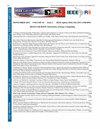评估可见光通信中 RGB 信道的太阳能电池板带宽
IF 1.3
4区 工程技术
Q3 COMPUTER SCIENCE, INFORMATION SYSTEMS
引用次数: 0
摘要
可见光通信(VLC)是一种利用白色发光二极管(LED)同时传输信息和提供照明的新兴技术。最近,有人提出将太阳能电池板作为接收器的光学探测器,从光信号中获取数据。然而,很少有研究涉及太阳能电池板带宽在不同波长下的行为。在本文中,我们提出了一种低复杂度 VLC 系统的设计方案,该系统包含一个红-绿-蓝(RGB)LED 发射器和一个太阳能电池板接收器,其带宽可通过并联负载电阻进行修改。我们定义了一组实验,以验证使用 RGB LED 光源和太阳能电池板作为光学接收器的 VLC 系统的性能。我们在小于 105 厘米的自由空间传输距离内,通过不同的波特率(4800、9600、19200、38400、57600 和 115200 比特/秒)对 VLC 系统的性能进行了评估。我们的测量结果表明,太阳能电池板的最高带宽是通过红色信道实现的,在误码率(BER)为 5 103 的情况下,最大数据传输速率为 57600 比特/秒。我们对这些结果进行了分析和讨论,以强调将太阳能电池板用于 VLC 的好处和局限性。本文章由计算机程序翻译,如有差异,请以英文原文为准。
Evaluation of Solar Panel Bandwidth for RGB Channels in Visible Light Communication
Visible light communication (VLC) is an emerging technology that uses white light-emitting diodes (LEDs) to transmit information and provide illumination simultaneously. Recently, solar panels have been proposed as optical detectors at the receiver to retrieve data from light signals. However, very few studies have addressed the behavior of the solar panel bandwidth at different wavelengths. In this paper, we propose the design of a low-complexity VLC system with a red-green-blue (RGB) LED transmitter and a solar panel receiver whose bandwidth is modified using a parallel load resistor. We define a set of experiments to validate the performance of the VLC system using an RGB LED source and a solar panel as the optical receiver. The VLC systems performance is evaluated across various baud rates (4800, 9600, 19200, 38400, 57600, and 115200 bits/s) at a free space transmission distance of less than 105 cm. Our measurements indicate that the solar panels highest bandwidth is achieved with the red channel, yielding a maximum data rate of 57600 bits/s at a bit error rate (BER) of 5 103. These results are analyzed and discussed to highlight the benefits and limitations of using solar panels for VLC purposes.
求助全文
通过发布文献求助,成功后即可免费获取论文全文。
去求助
来源期刊

IEEE Latin America Transactions
COMPUTER SCIENCE, INFORMATION SYSTEMS-ENGINEERING, ELECTRICAL & ELECTRONIC
CiteScore
3.50
自引率
7.70%
发文量
192
审稿时长
3-8 weeks
期刊介绍:
IEEE Latin America Transactions (IEEE LATAM) is an interdisciplinary journal focused on the dissemination of original and quality research papers / review articles in Spanish and Portuguese of emerging topics in three main areas: Computing, Electric Energy and Electronics. Some of the sub-areas of the journal are, but not limited to: Automatic control, communications, instrumentation, artificial intelligence, power and industrial electronics, fault diagnosis and detection, transportation electrification, internet of things, electrical machines, circuits and systems, biomedicine and biomedical / haptic applications, secure communications, robotics, sensors and actuators, computer networks, smart grids, among others.
 求助内容:
求助内容: 应助结果提醒方式:
应助结果提醒方式:


